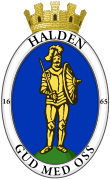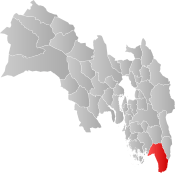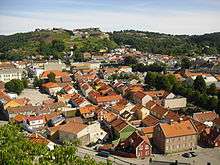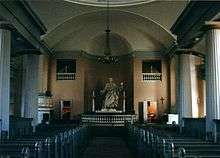Halden
Halden (![]()
Halden kommune | |
|---|---|
Halden as seen from the Fredriksten fortress in mid-July 2012 | |
 Coat of arms  Viken within Norway | |
 Halden within Viken | |
| Coordinates: 59°7′35″N 11°28′58″E | |
| Country | Norway |
| County | Viken |
| Administrative centre | Halden |
| Government | |
| • Mayor (2014) | Thor Edquist (H) |
| Area | |
| • Total | 642 km2 (248 sq mi) |
| • Land | 596 km2 (230 sq mi) |
| Area rank | 173 in Norway |
| Population (2019) | |
| • Total | 31 175 |
| • Rank | 18 in Norway |
| • Density | 46/km2 (120/sq mi) |
| • Change (10 years) | 6.0% |
| Demonym(s) | Haldenser/Haldensar[1] |
| Time zone | UTC+01:00 (CET) |
| • Summer (DST) | UTC+02:00 (CEST) |
| ISO 3166 code | NO-3001 |
| Official language form | Bokmål[2] |
| Website | www |
The seat of the municipality, Halden is a border town located at the mouth of the Tista river on the Iddefjord, the southernmost border crossing between Norway and Sweden. The town of Halden is located about 120 km (75 mi) south of Oslo, 190 km (120 mi) north of Gothenburg, and 12 km (7.5 mi) east of the border crossing at Svinesund.
History
Evidence of early human settlements in this region of Norway have been found, particularly in the Svinesund area of the municipality where evidence of early settlements from the Nordic Bronze Age have been found. Named after a small farm Hallen (English: "rise" or "slope") first mentioned in 1629, "Halden", became the city of Frederikshald in 1665, named after Frederick III of Denmark. The Gud med oss (God be with us) coat-of-arms created in 1665 shows a knight standing on a mountain, yellow on a blue background, and was inspired by the bravery of the citizens of the city in the Dano-Swedish War (1658–1660).[3]
Swedish forces unsuccessfully attempted to invade the town six times between 1658 and 1814. As a reference to the town's citizens burning their own houses to prevent them being taken on 4 July 1716 by the forces of King Charles XII of Sweden, Halden is one of only two cities in Norway's national anthem. In 1718, the Great Northern War ended when Charles XII was shot and killed at the Fredriksten fortress. The fortress had been erected in the 17th century as a replacement for the Bohus Fortress lost at the Treaty of Roskilde in 1658 when Bohuslän was ceded to Sweden. Halden has never been captured by force by any invading army, although it was occupied by Nazi forces in WWII.
In an 1835 census, Frederikshald was the seventh largest town or city in Norway, with 4,921 inhabitants.[4] In 1838, Frederikshald became a city municipality (Norwegian: herred), and in 1928, the name was changed back to Halden. Tistedalen, which is 4 kilometres (2 mi) east of Halden, was part of the city from 1686 to 1967, until it was separated from Halden. At the same time, the area of Halden, Tistedalen, and the rural municipalities of Berg and Idd, became the Halden municipality on 1 January, 1967.

Politics
The political situation in Halden has become infamous in Norway for conflicts between individual politicians and between local political parties. The municipality is governed by the Conservative Party, the Liberal Party, the Christian Democratic Party, the Centre Party, and the Green Party.[5]

Economy
The slogan, Halden, IT- og Miljøbyen (Halden, IT and Environment City), is a reference to Halden's large number of information technology companies. In the late 1960s, the most powerful mainframe computer in Norway at the time was located at the Institute for Energy Technology's facilities in Halden. From the 1960s-1980s, Halden was infamous for high levels of industrial pollution, largely originating from the Norske Skog Saugbrugs paper mill (part of Norske Skog since 1989). As a result of projects initiated by both Norske Skog-Saugbrugs and the city authorities, the polluted fjords and rivers of Halden have been cleaned up and the city was dubbed Norway's Environment City in 1996.
One of Norway's two nuclear reactors is located in Halden. The Halden Boiling Water Reactor is a research reactor located 100 metres (328 ft) within Månefjell, adjacent to the Saugbrugs paper mill. It is in operation about 50% of the time and, in addition to research data, supplies steam to the mill. The reactor is operated by the Institute for Energy Technology, one of Halden's largest employers, and is the largest experimental facility operated for OECD Halden Reactor Project research. IFE's Man-Technology-Organisation laboratory is IFE's other major facility, and was opened by Norway's crown prince regent in March 2004. This new laboratory building houses the most recent incarnations of the Halden Man-Machine Laboratory (HAMMLAB) and Halden Virtual Reality Centre's (HVRC) VR laboratory. The OECD Halden Reactor Project (established in 1958) is one of the world's longest running international research collaborations, with 20 countries participating (2005) and the largest international research project in Norway. This ensures a steady influx of international guest scientists to the city. The fact that Norway has no commercial interest in nuclear power ensures that Halden is viewed internationally as a neutral location. In national politics, the reactor is controversial, however locally it has had support from the majority of political parties and the city's population. Some of the largest IT companies in Halden, such as Hand-El Skandinavia (now part of the OM Technology group) and ScandPower, are spin-offs from IFE.
Nexans has a large cable factory in Halden. The main products from this factory are submarine power cables, umbilical cables for subsea installations, and cable systems for heating of subsea pipelines.
Rød Herregård
Rød Herregård in Halden is one of the best preserved manor houses in Norway. The property features well-preserved buildings, a baroque garden and an English landscape garden. The buildings have their oldest origins of the late 1600s, but were largely built during the last half of the 1700s. The main building contains authentic furnishings including period furniture, hunting trophies, an extensive collection of art and a large weapons collection. [6]
Rød Herregård was owned and inhabited by members of the Tank and Anker families from 1733 including Carsten Tank and Nils Otto Tank as well as Peter Martin Anker and Nils Anker. The manor house and estate complex was owned by the Tank family through three generations, from 1733 to 1829. Both Danish Crown Prince regent Christian Frederik and Swedish Crown Prince and Regent Charles John were guests at the mansion. The estate was visited by English economist Thomas Robert Malthus during his European tour in 1799. [7][8] [9]
In 1961, two foundations were established to maintain the historic property. Rød Manor Foundation (Stiftelsen Rød Herregård) is responsible for the manor house, buildings and gardens. Ankerske Foundation Collections (Stiftelsen De Ankerske Samlinger) is responsible for the contents and the rich archives related to the property.[10]
Notable Sights
Halden sights include the Halden Canal system, the two Svinesund bridges, and Høiåsmasten, a partially guyed TV tower. The fortress of Fredriksten has historical museums, and the Østfold University College (Høgskolen i Østfold) is in Halden.
Petroglyphs (rock carvings) dated from the Nordic Bronze Age are found around town, some locally, but more impressive are ones found along Oldtidsveien, the historical road between Halden and Fredrikstad some 20 km (12 mi) north, and around Tanum in Sweden, some 60 km (37 mi) to the south. Jellhaugen, a major tumulus (grave mound) is found west of town.[11]
Nature
Halden is surrounded by forests and water so hiking and fishing locations can easily be found. Deer and elk are a common sight, and wolves have also been observed in the district along the border with Sweden. Raspberries, blackberries, blueberries, wild cranberries, and many varieties of mushroom can be found in the woods in the early autumn. Popular destinations for hikers and other nature lovers include Prestebakke and Kornsjø.
Halden's meteorological station is at Buer.[12]

Culture
Outdoor concerts are frequently held at the fortress while the local churches, pubs, and student union are regular venues for indoor concerts. Musicians recorded by the Hitsville and Athletic Sound studios in the Halden region include Motorpsycho, Madrugada, Morten Harket, and Kurt Nilsen. The city's intimate theatre hosts frequent plays by national and local theatre groups, and occasionally serves as a concert hall.
Halden festivals include Tons of Rock (hard rock and metal) in June each year (from 2014 before the festival was moved to Oslo in 2019) and a vegetarian food festival in August. The famous pub "Siste Reis" neighbouring the train station has been voted among the ten best pubs in Europe!
Artists born in Halden that are represented in the Norwegian National Gallery in Oslo include Thomas Fearnley (1802–1842) and Jacob Mathias Calmeyer (1802–1883). Fearnley is locally exhibited at the manor house Rød Herregård. Other significant artists that lived in Halden, but were not born there, include Johannes Fintoe (1786–1870) and Heinrich August Grosch (1763–1843). Grosch's son, Christian Heinrich Grosch (1801–1865), who moved with his parents to Halden at the age of ten, became an influential architect, whose works include seventy-eight churches (including Immanuel Church in Halden), the Bank of Norway, the Oslo Stock Exchange, and the original university buildings in Oslo.
Sports
The Halden VBK volleyball club plays in the Premier Division, and while the local ice hockey team Comet did play in the GET-league (Norway's highest ice hockey division) for some years, but they ran into some financial problems in 2008/2009, and is now in division 1. Halden also has many football clubs, the biggest of them, Kvik Halden FK, plays in the Norwegian Second Division. The two handball clubs, Tistedalens TIF in the first division and HK Halden, have teams for children, youth and adults.
One of Norway's few curling centres lies in Halden. Halden Curling Center is host to East-Norway 1 division. In addition there is a separate amateur league with two divisions. Several curlers from Halden have won Norwegian championships and competed internationally.
Halden's forests are a good place for orienteering; and hiking, canoeing, boating, fishing, and gymnastics are also popular sports amongst Halden's population.
| Ancestry | Number |
|---|---|
| 566 | |
| 483 | |
| 419 | |
| 342 | |
| 196 | |
| 145 | |
| 135 | |
| 133 | |
| 107 | |
| 107 |
Halden's Prison
Halden is one of Norway's highest-security jails. It has acquired a “reputation as the world's most humane prison.” The architectural design of this prison is not like other prisons. The conditions inside the prison have been made as much like life outside the walls as possible. It is in fact to create an environment “as unprisonlike as possible.” This reflects the flagship of the Norwegian justice system, which focuses on rehabilitation rather than punishment.[14]
Notable residents
- Ivar Huitfeldt (1665–1710), commander in the Dano-Norwegian fleet
- Hans Jacob Arnold Jensen (1777-1853), Norwegian military officer and politician
- Nils Otto Tank (1800–1864), Moravian Church religious leader
- Christian Heinrich Grosch (1801–1865), architect
- Thomas Fearnley (1802–1842), artist
- Annette Abigael Hamilton (1806-1879), fairy-tale collector
- Alvilde Prydz (1846–1922), Novelist
- Nini Roll Anker (1873–1942), writer
- Karl Ouren (1882–1943), Norwegian-American artist
- Henning Kvitnes (1958-), Singer/songwriter (Rock/roots)
- Håkon Wium Lie (1965-), CTO of Opera Software
- Freddy Samuelsen (1978-), known as the Grand Old Sharkman, renown Shark’s Advocate
International relations
Twin towns — sister cities
The following cities are twinned with Halden:[15]




References
- "Navn på steder og personer: Innbyggjarnamn" (in Norwegian). Språkrådet.
- "Forskrift om målvedtak i kommunar og fylkeskommunar" (in Norwegian). Lovdata.no.
- "Haldens kommunevåpen" (in Norwegian). Archived from the original on 2011-07-24. Retrieved 2008-12-13.
- https://www.ssb.no/a/histstat/nos/st_08r_1836-45.pdf
- http://www.halden.kommune.no/politikk/Sider/side.aspx
- "Rød Herregård". Østfoldmuseene. Retrieved January 25, 2016.
- "Rød Herregård". ostfold1814. Retrieved June 20, 2016.
- Jon Gunnar Arntzen. "Anker". Store norske leksikon. Retrieved June 20, 2016.
- Jon Gunnar Arntzen. "Anker". Store norske leksikon. Retrieved June 20, 2016.
- "Rød Herregård". Østfoldmuseene. Retrieved June 20, 2016.
- "Jellhaugen". Kulturminnesøk. Retrieved September 1, 2017.
- http://www.yr.no/place/Norway/%C3%98stfold/Halden/Buer_stasjon/
- "Immigrants and Norwegian-born to immigrant parents, by immigration category, country background and percentages of the population". ssb.no. Retrieved 23 June 2017.
- Gentleman, Amelia. "Inside Halden, the most humane prison in the world". Retrieved 12 December 2018.
- "Vennskapsbyer" (in Norwegian). Halden kommune. Archived from the original on 2008-06-07. Retrieved 2008-12-16.
External links
| Wikimedia Commons has media related to Halden. |
| Wikimedia Commons has media related to Rød herregård. |
| Look up Halden in Wiktionary, the free dictionary. |

- Municipal fact sheet from Statistics Norway

